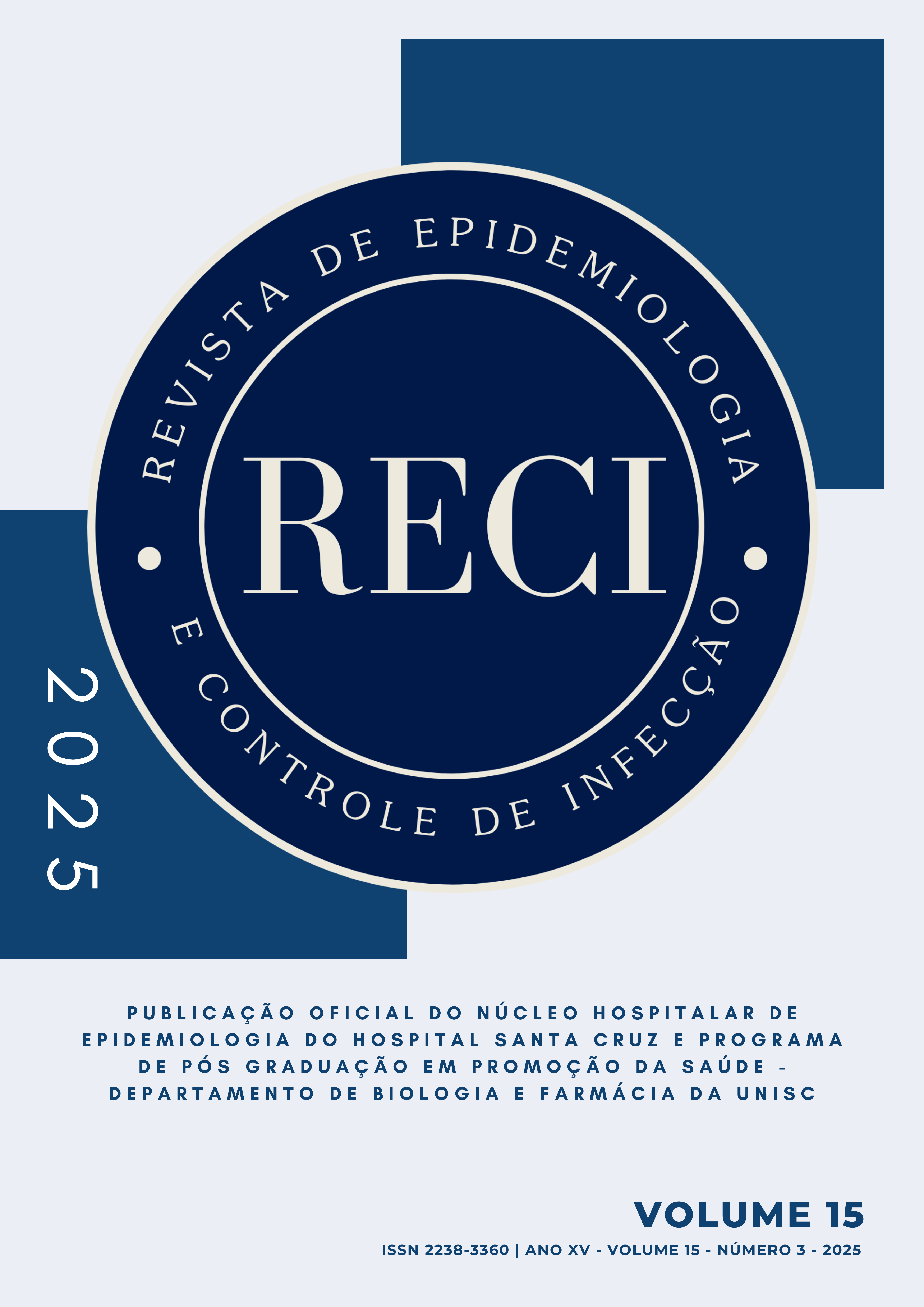Desarrollo de equipo para la desinfección por radiación ultravioleta en entornos sanitarios
DOI:
https://doi.org/10.17058/reci.v15i3.20108Palabras clave:
Descontaminación. Desinfección. Rayos Ultravioleta. Luz UV. Radiación No Ionizante.Resumen
Justificativa y Objetivos: En los hospitales, donde circulan muchos microorganismos, las tecnologías complementarias son clave para mejorar la desinfección. Este estudio tuvo como objetivo desarrollar una tecnología adaptada a nuestra realidad, que sea segura y fácil de operar, con bajo costo de construcción para que pueda ser utilizada en entornos de salud como los hospitales con recursos limitados. Métodos: Después de la investigación, se eligieron lámparas de 55W, T8 - G13 - 909 mm con emisión de radiación ultravioleta a 254 nm como fuente UVC. La aplicación “Torre UVC” se creó con el IDE de Android Studio. Para verificar la eficiencia de la torre UVC y determinar las dosis a utilizar, se tomaron medidas de potencia utilizando un radiómetro. Se evaluó la eficiencia de la torre frente a algunos microorganismos clínicamente importantes. Resultados: La Torre UVC fue construida con un marco de aluminio y 8 lámparas, lo que permite la operación remota. La aplicación fue diseñada para un uso fácil e intuitivo. Las pruebas de eficiencia realizadas con el radiómetro demuestran que la disminución de la dosis de radiación es exponencial a medida que los objetos o superficies se alejan de la torre. La torre inhibió eficazmente el crecimiento microbiano incluso con dosis bajas de radiación UVC (12 mJ/cm²) y redujo la carga viral de la muestra clínica positiva para SARS-CoV-2. Conclusión: Se desarrolló una tecnología segura, fácil de usar y de bajo costo, con resultados satisfactorios en la desinfección de microorganismos, adecuada para ser implementada en ambientes sanitarios.
Descargas
Referencias
1. Jerry J, O'Regan E, O'Sullivan L, et al. Do established infection prevention and control measures prevent spread of SARS-CoV-2 to the hospital environment beyond the patient room? J Hosp Infect. 2020;105(4):589-592. doi:10.1016/j.jhin.2020.06.026.
2. Wang D, Hu B, Hu C, et al. Clinical characteristics of 138 hospitalized patients with 2019 novel coronavirus-infected pneumonia in Wuhan, China. JAMA. 2020;323(11):1061-1069. doi:10.1001/jama.2020.1585.
3. Ling Y, Xu SB, Lin YX, et al. Persistence and clearance of viral RNA in 2019 novel coronavirus disease rehabilitation patients. Chin Med J (Engl). 2020;133(9):1039-1043. doi:10.1097/CM9.0000000000000774.
4. Odoyo E, Matano D, Tiria F, et al. Environmental contamination across multiple hospital departments with multidrug-resistant bacteria pose an elevated risk of healthcare-associated infections in Kenyan hospitals. Antimicrob Resist Infect Control. 2023 Mar 29;12(1):22. doi:10.1186/s13756-023-01227-x.
5. Moccia G, Motta O, Pironti C, et al. An alternative approach for the decontamination of hospital settings. J Infect Public Health. 2020;13(12):2038-2044. doi:10.1016/j.jiph.2020.09.020.
6. Bhardwaj SK, Singh H, Deep A, et al. UVC-based photoinactivation as an efficient tool to control the transmission of coronaviruses. Sci Total Environ. 2021;792:148548. doi:10.1016/j.scitotenv.2021.148548.
7. Enaki NA, Paslari T, Bazgan S, et al. UVC radiation intensity dependence of pathogen decontamination rate: semiclassical theory and experiment. Eur Phys J Plus. 2022;127(9):1047. doi:10.1140/epjp/s13360-022-03252-y.
8. Grist SM, Geldert A, Gopal A, et al. Current understanding of ultraviolet-C decontamination of N95 filtering facepiece respirators. Appl Biosaf. 2021;26(2):90-102. doi:10.1089/apb.20.0051.
9. Riu F, Ruda A, Ibba R, et al. Antibiotics and carbohydrate-containing drugs targeting bacterial cell envelopes: an overview. Pharmaceuticals (Basel). 2022;15(8):942. doi:10.3390/ph15080942.
10. Frías-De-León MG, Hernández-Castro R, Conde-Cuevas E, et al. Candida glabrata antifungal resistance and virulence factors, a perfect pathogenic combination. Pharmaceutics. 2021 Sep 22;13(10):1529. doi:10.3390/pharmaceutics13101529.
11. Guridi A, Sevillano E, de la Fuente I, et al. Disinfectant activity of a portable ultraviolet C equipment. Int J Environ Res Public Health. 2019;16(23):4747. doi:10.3390/ijerph16234747.
12. Santos T, de Castro LF. Evaluation of a portable Ultraviolet C (UV-C) device for hospital surface decontamination. Photodiagnosis Photodyn Ther. 2020;33:102161. doi: 10.1016/j.pdpdt.2020.102161.
13. Fox-Lewis A, Fox-Lewis S, Beaumont J, et al. SARS-CoV-2 viral load dynamics and real-time RT-PCR cycle threshold interpretation in symptomatic non-hospitalised individuals in New Zealand: a multicentre cross sectional observational study. Pathology. 2021;53(4):530-535. doi:10.1016/j.pathol.2021.01.007.
14. Zou L, Ruan F, Huang M, et al. SARS-CoV-2 viral load in upper respiratory specimens of infected patients. N Engl J Med. 2020;382(12):1177-1179. doi:10.1056/NEJMc2001737.
15. Veronesi L, Colucci ME, Pasquarella C, et al. Virological surveillance of SARS-CoV-2 in an Italian northern area: comparison of real time RT-PCR cycle threshold (Ct) values in three epidemic periods. Acta Biomed. 2020;91(9-S):19-21. doi:10.23750/abm.v91i9-S.10138.
16. Aranha C, Patel V, Bhor V, et al. Cycle threshold values in RT-PCR to determine dynamics of SARS-CoV-2 viral load: an approach to reduce the isolation period for COVID-19 patients. J Med Virol. 2021;93(12):6794-6797. doi:10.1002/jmv.27206.
17. Buonanno M, Welch D, Shuryak I, et al. Far-UVC light (222 nm) efficiently and safely inactivates airborne human coronaviruses. Sci Rep. 2020;10(1):10285. doi:10.1038/s41598-020-67211-2.
18. Gidari A, Sabbatini S, Bastianelli S, et al. SARS-CoV-2 survival on surfaces and the effect of UV-C light. Viruses. 2021;13(3):408. doi:10.3390/v13030408.
19. Dexter F, Parra MC, Brown JR, et al. Perioperative Covid-19 defense: an evidence-based approach for optimization of infection control and operating room management. Anesth Analg. 2020;131(1):37-42. doi:10.1213/ANE.0000000000004829.
20. Zaman A, Majib MS, Tanjim SA, et al. UVC-PURGE: A novel cost-effective disinfection robot for combating Covid-19 pandemic. IEEE Access. 2022;S/N(1):37613-37634. doi: 10.1109/ACCESS.2022.3163243.
Descargas
Publicado
Número
Sección
Licencia
Derechos de autor 2025 Aline Teichmann, Demis Pessatto Faqui, Eduardo Dullius , Gilson Augusto Helfer, Nayanna Dias Bierhals , Maitê Souza Magdalena, Andréia Rosane de Moura Valim , Jane Dagmar Pollo Renner , Janine Koepp, Mari Ângela Gaedke, Adilson Ben da Costa

Esta obra está bajo una licencia internacional Creative Commons Atribución 4.0.
The author must state that the paper is original (has not been published previously), not infringing any copyright or other ownership right involving third parties. Once the paper is submitted, the Journal reserves the right to make normative changes, such as spelling and grammar, in order to maintain the language standard, but respecting the author’s style. The published papers become ownership of RECI, considering that all the opinions expressed by the authors are their responsibility. Because we are an open access journal, we allow free use of articles in educational and scientific applications provided the source is cited under the Creative Commons CC-BY license.


